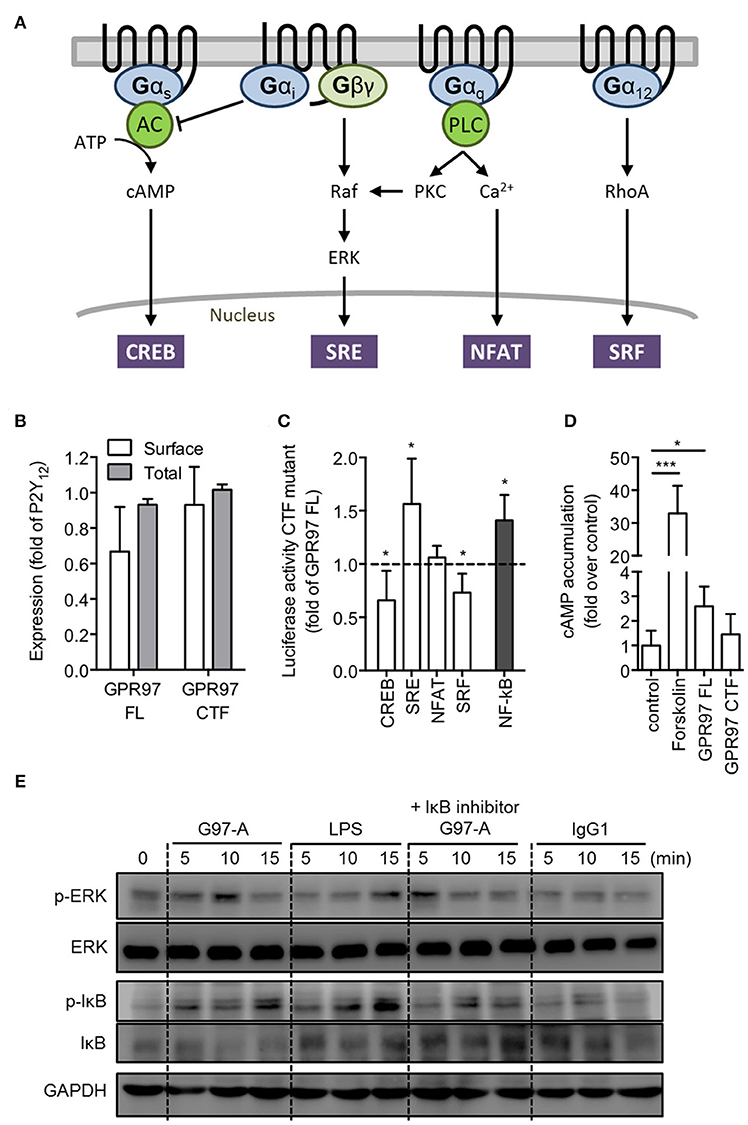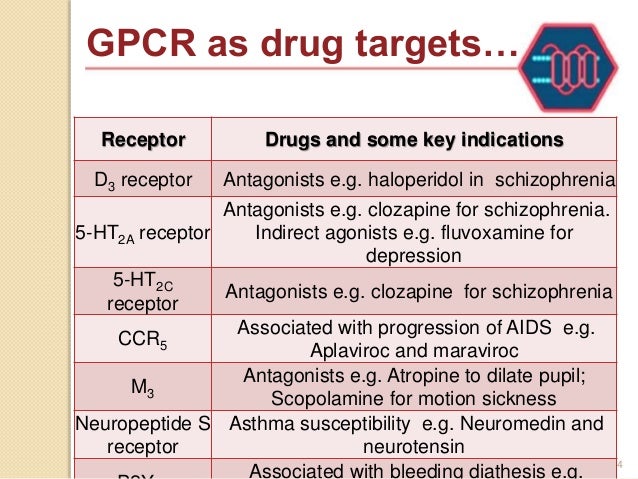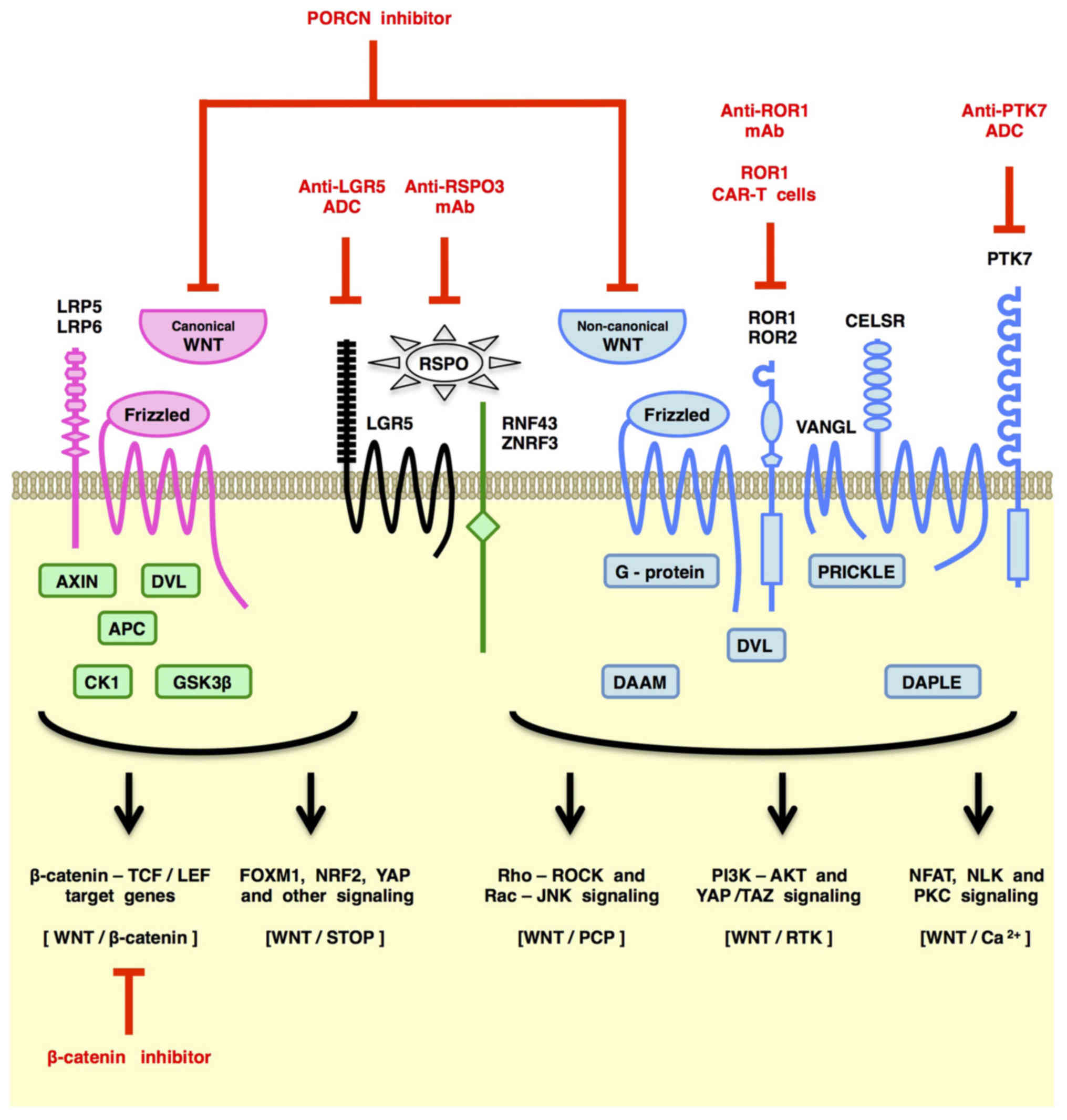
G protein-coupled receptor
G protein-coupled receptors (GPCRs), also known as seven-(pass)-transmembrane domain receptors, 7TM receptors, heptahelical receptors, serpentine receptor, and G protein–linked receptors (GPLR), constitute a large protein family of receptors that detect molecules outside the ce…
Full Answer
How is the G protein–coupled receptor activated?
An external signal, such as a ligand or another signal mediator, activates the G protein-coupled receptor. This causes a conformational shift in the receptor, resulting in G protein activation. The type of G protein has an additional effect. G proteins are then inactivated by RGS proteins, which are GTPase activating proteins.
What are G-protein-coupled receptors?
G protein coupled receptors (GPCRs) are remarkably versatile signaling molecules. The members of this large family of membrane proteins are activated by a spectrum of structurally diverse ligands, and have been shown to modulate the activity of different signaling pathways in a ligand specific manner.
What happens when a G protein is activated?
Jan 08, 2021 · Introduction. G protein-coupled receptors (GPCRs) represent the largest protein family encoded by the human genome. Located on the cell membrane, they transduce extracellular signals into key physiological effects. 1 Their endogenous ligands include odors, hormones, neurotransmitters, chemokines, etc., varying from photons, amines, carbohydrates, …
What ligands bind G protein-coupled receptors?
G-Protein-Coupled Receptors [GPCRs] • largest family of transmembrane proteins in the human genome with more than 800 unique GPCRs. These receptors are coupled to intracellular GTP-binding proteins (G-proteins). Once activated, G-proteins trigger the production of a variety of second messengers (e.g. cyclic AMP [cAMP], inositol triphosphate [IP3], diacylglycerol [DAG], …

What do G protein coupled receptors activate?
G protein–coupled receptors (GPCRs) mediate the majority of cellular responses to external stimuli. Upon activation by a ligand, the receptor binds to a partner heterotrimeric G protein and promotes exchange of GTP for GDP, leading to dissociation of the G protein into α and βγ subunits that mediate downstream signals.
What does G protein activate?
Abstract. Heterotrimeric G proteins couple the activation of heptahelical receptors at the cell surface to the intracellular signaling cascades that mediate the physiological responses to extracellular stimuli.
Are G protein coupled receptors activated by antagonists?
The GPCR can then activate an associated G protein by exchanging the GDP bound to the G protein for a GTP....CHEBI:88295 - G-protein-coupled receptor antagonist.ChEBI NameG-protein-coupled receptor antagonistDefinitionAn antagonist at G-protein-coupled receptor.StarsThis entity has been manually annotated by the ChEBI Team.4 more rows•Oct 20, 2015
How do G proteins regulate intracellular Signalling?
G Protein Coupled Receptors (GPCRs) perceive many extracellular signals and transduce them to heterotrimeric G proteins, which further transduce these signals intracellular to appropriate downstream effectors and thereby play an important role in various signaling pathways. ... GPCRs also regulate cell cycle progression.
Why are G protein-coupled receptors important?
G protein-coupled receptors (GPCRs) mediate senses such as odor, taste, vision, and pain (1) in mammals. In addition, important cell recognition and communication processes often involve GPCRs. Indeed, many diseases involve malfunction of these receptors (2), making them important targets for drug development.Oct 1, 2002
Where are G protein-coupled receptors activated by G proteins?
plasma membraneAs their name implies, GPCRs interact with G proteins in the plasma membrane. When an external signaling molecule binds to a GPCR, it causes a conformational change in the GPCR. This change then triggers the interaction between the GPCR and a nearby G protein.
What is an antagonist for a receptor What would an antagonist do?
A receptor antagonist is a type of receptor ligand or drug that blocks or dampens a biological response by binding to and blocking a receptor rather than activating it like an agonist. Antagonist drugs interfere in the natural operation of receptor proteins.
Which hormones mainly act through G protein coupled receptors?
Abstract. The parathyroid hormone (PTH) type 1 receptor (PTHR) is a medically important class B G Protein Coupled Receptor (GPCR) that primarily couples to Gs/cAMP and Gq/Ca2 + signaling pathways and has a central role in regulating Ca2 + homeostasis and bone turnover via PTH.
What are G protein coupled receptors where are these receptors located in the cell how do they work?
G protein-coupled receptor (GPCR), also called seven-transmembrane receptor or heptahelical receptor, protein located in the cell membrane that binds extracellular substances and transmits signals from these substances to an intracellular molecule called a G protein (guanine nucleotide-binding protein).
What is the initial event that occurs when a G protein coupled receptor activates AG protein?
The G protein-coupled receptor is activated by an external signal in the form of a ligand or other signal mediator. This creates a conformational change in the receptor, causing activation of a G protein.
How is the G protein subunit activated quizlet?
Ligand binding to a receptor activates the G-protein, by allowing GTP to exchange for GDP at the β subunit, while the α and γ subunits dissociate. Ligand binding to a receptor activates the G-protein, by allowing GTP to exchange for GDP at the α subunit, while the β and γ subunits dissociate.
What is the primary role of G protein in the cell quizlet?
The G protein acts as a hormone receptor. Why is the plasma membrane a barrier for thyroid hormone to enter a cell, but steroid hormones pass through easily?
What are the functions of G-proteins?
Once activated, G-proteins trigger the production of a variety of second messengers (e.g. cyclic AMP [cAMP], inositol triphosphate [IP3], diacylglycerol [DAG], etc.) helping to regulate a number of body functions ranging from sensation to growth to hormone release.
How many transmembrane helices are in a GPCR?
GPCR Structure • each GPCR is composed of 7 transmembrane helices connected by extracellular and intracellular loops. G-proteins • G proteins are made of aßg-trimers. In a resting state guanosine diphosphate (GDP) is bound to this trimer. Upon receptor activation by an agonist the G protein is attracted to the receptor.
Which receptors inhibit adenylyl cyclase?
cannabinoid, catecholamine, histamine, opioid, serotonin, and other receptors. inhibits adenylyl cyclase to decrease cAMP formation. Gas. catecholamine, histamine, serotonin and other receptors. stimulates adenylyl cyclase to increase cAMP formation.
What is the GPCR pathway?
GPCR Pathways. Cyclic AMP Pathway • An agonist stimulates the GPCR, which them activates the G-protein (Gas or Gai). Gas will go on to stimulate its target protein, adenylyl cyclase [ AC ], which catalyzes the conversion of ATP to cAMP. Gai inhibits adenylyl cyclase, which decreases cAMP (cyclic AMP) levels.
What are eicosanoids?
Eicosanoids • Eicosanoids are considered “local hormones” as their action takes place on nearby cells (paracrine hormones). Eicosanoids are involved with intracellular signaling by stimulating GPCRs coupled to G-protein subtypes Gs, Gq and G12/G13.
What is a GPCR?
In summary, GPCRs are transmembrane receptors that allow for extracellular signals to be communicated (by signal transduction) to intracellular effectors that eventually lead to a particular cellular response. As you can see above, each G-protein subtype initiates a particular signaling pathway.
What is the largest class of drug targets in the human body?
As already stated earlier (slide 1.2.3 ), G protein-coupled receptors (GPCRs) form the largest class of drug targets in the human body. It is therefore appropriate to examine and understand them in some detail. The human genome contains genes for several hundred GPCRs. For a bit less than half of these, the ligands and physiological functions ...
How many GPCRs are there in the human genome?
The human genome contains genes for several hundred GPCRs. For a bit less than half of these, the ligands and physiological functions are not yet known. Once these “orphan” receptors will have become “deorphanized”, at least some of them will probably become drug targets also. 5.1.1.
Which drug inhibits protein kinase A?
The experimental drug H-89 inhibits protein kinase A, which is activated downstream of β-receptors and adenylate cyclase.
Where are GPCRs located?
All GPCRs (with the exception of rhodopsin) are located in the cytoplasmic membrane. The snake diagram on the left shows the arrangement of the seven transmembrane helices: the N-terminus faces outward, and the C-terminus is located inside the cell.
Does CP-96345 compete with eledoisin?
CP-96345 displaces substance P from the wild-type NK 1 receptor (left) but does not effectively compete with eledoisin at the NK 3 receptor (right). When either of two short stretches located at the extracellular ends of transmembrane helices 5 or 6, respectively, in NK 1 is replaced by the homologous sequences from NK 3, the inhibitory potency of CP-96345 is greatly reduced. This indicates that binding of CP-96345 to the chimeric receptors is disrupted.
What is the G protein cycle?
The G protein cycle. GPCRs activate GTP-binding proteins, or G proteins for short, which in turn activate various effector proteins. G proteins are heterotrimers; their subunits are referred to by the Greek letters α, β and γ. G proteins undergo repeated cycles of activation and inactivation.
How is GPCR inactivated?
A GPCR will often be inactivated simply by dissociation of the agonist. However, some agonists may bind avidly and dissociate slowly, and with protease-activated receptors, activation is entirely irreversible. Therefore, additional mechanisms are needed to control receptor activity. One widely used mechanism for GPCR inactivation consists in phosphorylation.
Who is Kara Rogers?
Kara Rogers. Kara Rogers is the senior editor of biomedical sciences at Encyclopædia Britannica , where she oversees a range of content from medicine and genetics to microorganisms. She joined Britannica in 2006 and... See Article History. Alternative Titles: GPCR, heptahelical receptor, seven-transmembrane receptor.
Why are GPCRs important?
In addition, acquired mutations in certain GPCRs cause abnormal increases in receptor activity and expression in cell membranes, which can give rise to cancer. Because GPCRs play specific roles in human disease, they have provided useful targets for drug development.
What is the G protein?
Alternative Titles: GPCR, heptahelical receptor, seven-transmembrane receptor. G protein-coupled receptor (GPCR), also called seven-transmembrane receptor or heptahelical receptor, protein located in the cell membrane that binds extracellular substances and transmits signals from these substances to an intracellular molecule called a G protein ...
What is the GPCR?
A GPCR is made up of a long protein that has three basic regions: an extracellular portion (the N-terminus), an intracellular portion (the C-terminus), and a middle segment containing seven transmembrane domains . Beginning at the N-terminus, this long protein winds up and down through the cell membrane, with the long middle segment traversing ...
What are the two signal transduction pathways?
There are two principal signal transduction pathways involving the G protein-coupled receptors: the cAMP signal pathway and. the phosphatidylinositol signal pathway. When a ligand binds to the GPCR it causes a conformational change in the GPCR, which allows it to act as a guanine nucleotide exchange factor (GEF).
How many GPCRs are there in the human genome?
An early study based on available DNA sequence suggested that the human genome encodes roughly 750 G protein-coupled receptors, about 350 of which detect hormones, growth factors, and other endogenous ligands. Approximately 150 of the GPCRs found in the human genome have unknown functions.
Where are G protein-coupled receptors found?
G protein-coupled receptors are found only in eukaryotes, including yeast, choanoflagellates, and animals.
Who won the 2012 Nobel Prize for Chemistry?
The 2012 Nobel Prize in Chemistry was awarded to Brian Kobilka and Robert Lefkowitz for their work that was "crucial for understanding how G protein-coupled receptors function". There have been at least seven other Nobel Prizes awarded for some aspect of G protein–mediated signaling.
What is the binding of a GPCR?
It is known that in the inactive state, the GPCR is bound to a heterotrimeric G protein complex. Binding of an agonist to the GPCR results in a conformational change in the receptor that is transmitted to the bound G α subunit of the heterotrimeric G protein via protein domain dynamics.
How do GPCRs become desensitized?
GPCRs become desensitized when exposed to their ligand for a long period of time. There are two recognized forms of desensitization: 1) homologous desensitization, in which the activated GPCR is downregulated; and 2) heterologous desensitization, wherein the activated GPCR causes downregulation of a different GPCR. The key reaction of this downregulation is the phosphorylation of the intracellular (or cytoplasmic) receptor domain by protein kinases .
When was the first GPCR solved?
In 2000, the first crystal structure of a mammalian GPCR, that of bovine rhodopsin ( 1F88 ), was solved. In 2007, the first structure of a human GPCR was solved This human β 2 -adrenergic receptor GPCR structure proved highly similar to the bovine rhodopsin.

Popular Posts:
- 1. how do i activate the dwarven mechanism in raldbthar deep market
- 2. how to activate a command by stepping on a certain block
- 3. how to activate envato theme code nulled
- 4. how to activate another account on ps4
- 5. how to activate dell windows on new hard drive without cd
- 6. how to activate windows 7 ultimate without internet connection
- 7. how to activate app developer membership once purchased
- 8. how to activate a plugin in cpanel website
- 9. how to activate windows 11 dev
- 10. how to activate a calling card on cod black ops 3 ?